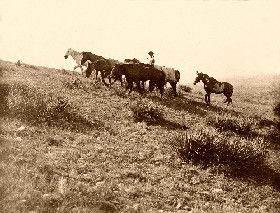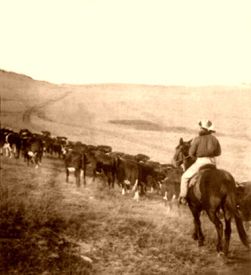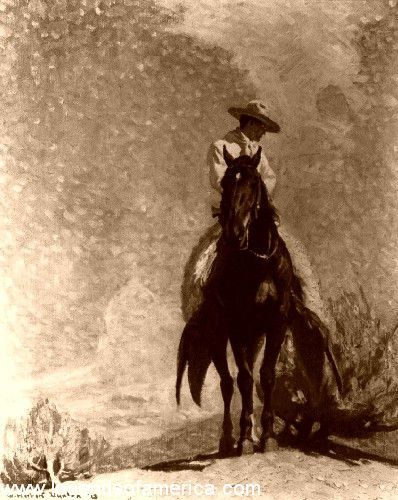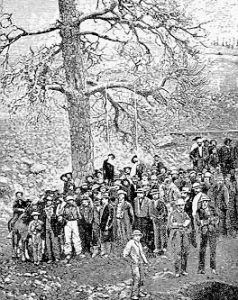By Emerson Hough in 1918
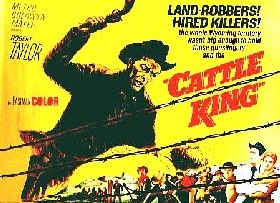
Cattle King.
After the railways came to the Plains, the Indians were vanishing, and the buffalo were not yet gone but were soon to pass.
Until the closing days of the Civil War, the northern range was a wide, open domain, the greatest ever offered for the use of a people. None claimed it then in fee; none wanted it in fee. The grasses and the sweet waters offered accessible and profitable chemistry for all men with cows in the range. The land laws still were vague and inexact in application, and each man could construe them much as he liked.
The excellent Homestead Act of 1862, one of the few really good land laws that have been put on our national statute books, worked well enough so long as we had good farming lands for homesteading–lands of which a quarter section would support a home and a family. This homestead law was the only one available on the cattle range. In practice, it was violated thousands of times — in fact, of necessity violated by any cattleman who wished to acquire sufficient range to run a considerable herd. Our great timber kings, our great cattle kings, made their fortunes out of their open contempt for the homestead law, which was designed to give all the people an even chance for a home and a farm. It made and lost America.
Swiftly enough, here and there along all the great waterways of the northern range, ranchers and their men filed claims on the waterfronts. The dry land thus lay tributary to them. For the most part, the open lands were held practically under squatter rights; the first cowman in any valley usually had his rights respected, at least for a time. These were the days of the open range. Fences had not come, nor had farms been staked out.
From the South now appeared that tremendous and elemental force — most revolutionary of all the great changes we have noted in the swiftly changing West — the bringing in of thousands of horned kine along the northbound trails. The trails were hurrying from the Rio Grande to the upper plains of Texas and northward, along the north and south line of the Frontier- that land we have been seeking less to define and to mark precisely than fundamentally to understand.
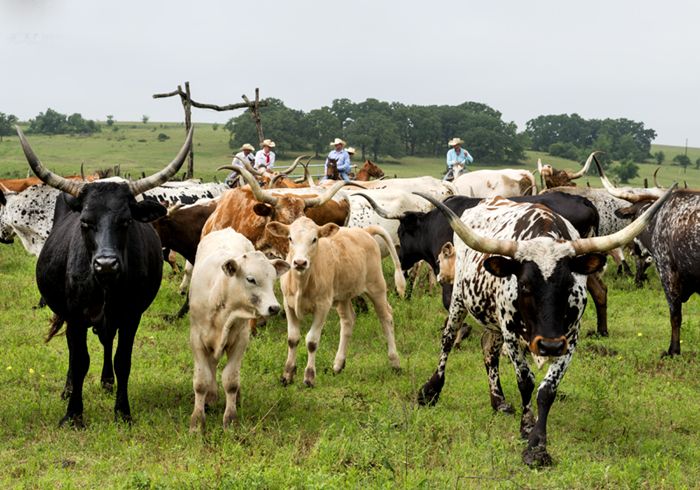
Modern-day cowboys herding longhorn cattle in Texas by Carol Highsmith.
The Indian wars had much to do with the cow trade. The Indians were crowded upon the reservations, and they had to be fed and fed on beef. Corrupt Indian agents made fortunes, and the Beef Ring at Washington, one of the most despicable lobbies whichever fattened there, now wrote its brief and unworthy history. In a strange way, corrupt politics and corrupt business affected the phases of the cattle industry as they had affected our relations with the Indians. More than once a herd of some thousand beeves driven up from Texas on contract, and arriving late in autumn, was not accepted on its arrival at the army post–some pet of Washington perhaps had his own herd to sell! All that could be done then would be to seek out a “holding range.” In this way, more and more, the capacity of the northern Plains to nourish and improve cattle became established.
Naturally, the price of cows began to rise, and naturally, the demand for open range steadily increased. There now began the whole complex story of leased lands and fenced lands. The frontier was still offering the bold man an opportunity to reap where he had not sown. Lands leased to the Indians of the civilized tribes began to cut a large figure in the cow trade — as well as some figure in politics — until, at length, the thorny situation was handled by a firm hand at Washington. The methods of the East were swiftly overrunning those of the West. Politics and graft and pull, things hitherto unknown, soon wrote their harrowing story, as well as overall this newly won region from which the rifle smoke had scarcely yet cleared away.
But every herd that passed north for delivery of one sort or the other advanced the education of the cowman, whether of the northern or the southern ranges. Some of the southern men began to start feeding ranges in the North, retaining their breeding ranges in the South. The demand for the great upper range for cattle seemed insatiable for the time.
According to the vision of railroad builders, a tremendous potential freightage now appeared. The railroad builders began to calculate that one day; they would parallel the northbound cow trail with iron trails of their own and compete with nature to carry this beef. The whole swift story of all that development, while the westbound rails were crossing and crisscrossing the newly won frontier, scarcely lasted 20 years. We began to hear in the East of the Chisholm Trail and of the Western Trail, which lay beyond it and of many smaller and intermingling branches. We heard of Ogallala, in Nebraska, the “Gomorrah of the Range,” the first great upper marketplace for the distribution of cattle to the swiftly forming northern ranches. The names of new rivers came upon our map, and beyond the first railroads, we began to hear of the Yellowstone, the Powder, the Musselshell, the Tongue, the Big Horn, and the Little Missouri Rivers.
The bold and carefree wildlife coming up from the South now in a mighty surging wave spread all over that new West, which offered the people of older lands a strange and fascinating interest. Everyone on the range had money; everyone was independent. Once more, it seemed that man had been able to overleap his life’s confining limitations and attain independence, self-indulgence, ease, and liberty. A chorus of Homeric, riotous mirth, as of land in laughter, rose up all over the great range. After all, it seemed that we had a new world left, a land not yet used. We were still young! The cry arose that there was land enough for all-out West. At first, the trains of white-topped wagons rivaled the crowded coaches westbound on the rails.
In consequence, there came an entire readjustment of values. This country, but yesterday barren and worthless, now was covered with gold, deeper than the gold of California or any of the old placers. New securities and new values appeared. Banks did not care much for the land as security–it was practically worthless without the cattle–but they would lend money on cattle at rates that did not then seem usurious. A new system of finance came into use. Side by side with the expansion of credits went the expansion of the cattle business. Literally, in hundreds of thousands, the cows came north from the exhaustless ranges of the lower country.
It was a wild, strange day. But withal it was the kindliest and most generous time, alike the most contented and the boldest time, in all the history of our frontiers.
There never was a better life than that of the cowman who had a good range on the Plains and cattle enough to stock his range. There never will be found a better man’s country in all the world than that which ran from the Missouri River up to the low foothills of the Rocky Mountains.
The lower cities took their tribute from the northbound cattle for quite a while. Wichita, Coffeyville, and other towns of lower Kansas, in turn, made bids for prominence as cattle marts. Agents of the Chicago stockyards would come down along the trails into the Indian Nations to meet the northbound herds and try to divert them to this or that market as a shipping point.
Not yet wholly confined to their reservations, the Kiowa and Comanche sometimes took tribute to the herds laboring upward through the long, slow season, whether in theft or open extortion. Trail-cutters and herd-combers, licensed or unlicensed hangers-on to the northbound throngs of cattle, appeared along the lower trails–with some reason, occasionally, for in a great northbound herd, there might be many cows included under brands other than those of the road brands registered for the drovers of that particular herd. Cattle thieving became an industry of certain value, rivaling in some localities the operations of the bandits of the placer camps. Great wealth was suddenly seen. The weak and the lawless, as well as the strong and the unscrupulous, set out to reap after their own fashion where they had not sown. If a grave here or there appeared along the trail or at the edge of the straggling town, it mattered little. If the gamblers and the desperadoes of the cow towns such as Newton, Ellsworth, Abilene, and Dodge City furnished a man for breakfast day after day, it mattered little, for plenty of me remained as good or better. The life was large and careless, and bloodshed was but an incident.
During the early and unregulated days of the cattle industry, the frontier insisted on its own creed and its own standards. But all the time, coming out from the East, were scores and hundreds of men of exacter notions of trade and business. The enormous waste of the cattle range could not long endure. The toll taken by the thievery of the men who came to be called range-rustlers made an element of loss that could not long be sustained by thinking men. As the vigilantes regulated things in the mining camps in a slightly different fashion, the new property owners on the upper range established their own ideas and their own sense of proportion as to law and order. The cattle associations, the banding together of many owners of vast herds for mutual protection and mutual gain, were a natural and logical development. Outside of these, there was, for a time, a highly efficient corps of cattle-range vigilantes who shot and hanged some scores of rustlers.
It was a frenzied life while it lasted–this lurid outburst, the last flare of the frontier. Such towns as Dodge City, Kansas, and Ogallala, Nebraska, offered extraordinary phenomena of unrestraint. Fortunately, into the worst of these capitals of license came the best men of the new regime and the new law officers, the agents of the vigilantes, the advanced guard of civilization now crowding on the heels of the wild men of the West. In time,e the lights of thedance halls,e saloon,s and gambling parlors went out one by one all along the frontier.
By 1885, Dodge City, a famed capital of the cow trade, would live as long as the history of that industry is known. It resigned its eminence and declared that from where the sun then stood, it would be a cow camp no more! The men of Dodge knew that another day had dawned. But this was after the homesteaders had arrived and put up their wire fences, cutting off from the town the holding grounds of the northbound herds.
This innovation of barb-wire fences in the 1870s caused a tremendous alteration in conditions in the country. It enabled men to fence in their own water-fronts and homesteads. Casually, and at first, without any objection filed by anyone, they had included many hundreds of thousands of acres of rangeland in their fences to which they had no title whatever. These men–like the large-handed cow barons of the Indian Nations, who had things much as they willed in a little unnoted realm all their own–had money and political influence. And there still seemed to be enough range for all. If a man wished to throw a drift fence here or there, what mattered it?
Up to this time, not much attention had been paid to the Little Fellow, the man of small capital who registered a brand of his own, and who, with a maverick here and there and the natural increase, and perhaps a trifle of unnatural increase here and there–had proved able to accumulate with more or less rapidity a herd of his own. Now, the cattle associations passed rules that no foreman should be allowed to have or register his own brand. Not that any foreman could be suspected — not at all! — but the foreman who insisted on his old right to own a running iron and a registered brand was politely asked to find his employment elsewhere.
The old range’s large-handed and once generous methods now began to narrow themselves. Even if the Little Fellow could throw a fence around his own land, very often, he did not have enough land to support his herd with profit. A certain antipathy now began to arise between the great cattle owners and the small ones, especially on the upper range, where some rather bitter wars were fought — the cow kings accusing their smaller rivals of rustling cows, the small man accusing the larger operators of having for years done the same thing, and of having grown rich at it.
The cattle associations, thrifty and shifty, sending their brand inspectors as far east as the stockyards of Kansas City and Chicago, naturally had the whip hand of the smaller men. They employed detectives who regularly combed out the country in search of men who had loose ideas of mine and thine. All the time, the cow game was becoming stricter and harder. Easterners introduced the East’s idea of property, low interest, sure returns, and good security. In short, there was set on once more–as there had been in every great movement across the entire West– the old contest between property rights and human independence in action. It was now once more the Frontier against the States, and the States were foredoomed to win.
The barb-wire fence, which was used extensively by the great operators at first, came at last to be the greatest friend of the Little Fellow on the range. The Little Fellow, who, under the provisions of the Homestead Act, began to push West, to depart farther and farther from the protecting lines of the railways, could locate land and water for himself and fence in both. “I’ve got the law back of me,” was what he said, and what he said was true. Around the old cow camps of the trails and around the young settlements which did not aspire to be called cow camps, the homesteaders fenced in the land — so much land that there came to be no place near any of the shipping points where a big herd from the South could be held. Artificial barriers to the long drive began to be raised along the southern range. It would be hard to say whether fear of Texas competition or of Texas cattle fever was the more powerful motive in the minds of ranchers in Colorado and Kansas. But the cattle quarantine laws of 1885 nearly broke up the long drive of that year. Men began to talk of fencing off the trails and keeping the northbound herds within the fences, which was obviously impossible.
The railroads soon rendered this discussion needless. Their agents went down to Texas and convinced the shippers that it would be cheaper and safer to put their cows on cattle trains and ship them directly to the ranges where they would be delivered. And in time, the rails running north and south across the Staked Plains into the heart of the lower range began to carry most of the cattle. So, ended the old cattle trails.
What date shall we fix for the sun’s setting of that last frontier? Perhaps the year 1885 is as accurate as any — the time when the cattle trails practically ceased to bring forth their vast tribute. But, in fact, there is no exact date for the passing of the frontier. Its decline set in on what day the first lank “nester” from the States outspanned his sun-burned team as he pulled up beside some sweet water on the rolling lands somewhere in the West, and looked about him, and looked again at the land map held in his hand.
“I reckon this is our land, Mother,” said he.
When he said that, he pronounced the doom of the old frontier.
By Emerson Hough, 1918. Compiled and edited by Kathy Alexander/Legends of America, updated April 2024.
Excerpted from the book The Passing of the Frontier, A Chronicle of the Old West, by Emerson Hough, Yale University Press, 1918. (now in the public domain). Emerson Hough (1857–1923).was an author and journalist who wrote factional accounts and historical novels of life in the American West. His works helped establish the Western as a popular genre in literature and motion pictures. For years, Hough wrote the feature “Out-of-Doors” for the Saturday Evening Post and contributed to other major magazines.
Also See:
List of Trail Blazers, Riders, & Cowboys

